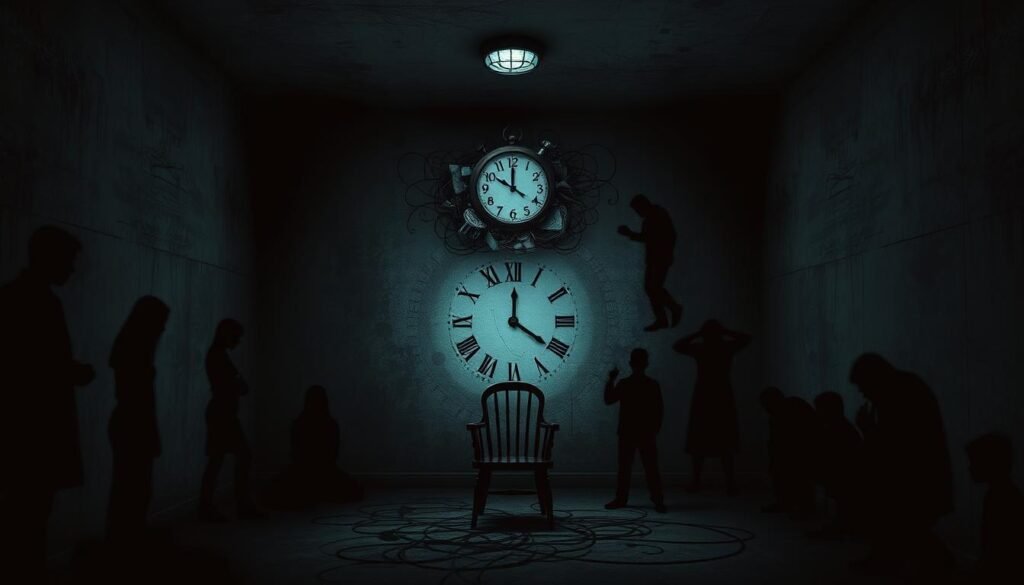About one in six people will face a major depressive episode in their lifetime. This fact shows how common Major Depressive Disorder (MDD) is around us. Every year, about 16 million adults are found to have clinical depression. It impacts people of all ages, races, and backgrounds. This article will help you understand MDD well. You’ll learn about its symptoms, types, causes, and how to diagnose and treat it.
In the U.S., 17.3 million adults deal with this mental issue each year—7.1% of the adult population. It’s crucial to fight the stigma around depression. Everyone should know that depression is something you can treat. There are ways to get help and support.
Key Takeaways
- Major Depressive Disorder affects a diverse range of individuals across different demographics.
- Approximately 17.3 million adults face this mental health issue in the U.S. each year.
- Symptoms of MDD can be emotional, physical, and behavioral.
- Effective treatment often involves a combination of medication and psychotherapy.
- Integrating lifestyle changes can improve mental well-being for those with MDD.
- Around 30% of individuals with depression do not respond to typical treatments.
- Understanding and managing MDD is vital to improving quality of life.
Understanding Major Depressive Disorder (MDD)
Understanding Major Depressive Disorder means looking at its emotional, biological, and social aspects. It’s a common mental health issue in the U.S. It greatly affects a person’s life. The problem usually starts in adulthood but can happen at any age. It’s often caused by a history of depression in the family or big life changes, like trauma or loss.
For a diagnosis, symptoms must last at least two weeks. Signs can include feeling sad or anxious, losing interest in everyday things, eating more or less than usual, and trouble sleeping. MDD is more than feeling down. It can connect to severe health problems like diabetes, cancer, and heart issues.
About 29% of adults have been diagnosed with depression sometime. In 2023, around 18% of adults are dealing with it right now. It affects women more than men. Younger people, especially, face it more than older ones. Usually, depression starts showing up from late teens to mid-20s.
Treatment options work. They include medications and therapy, often used together. Antidepressants might take a few weeks to start working. Cognitive behavioral therapy (CBT) can really make a difference. Things like exercising, eating healthily, and good sleep can also ease depression symptoms.
Overview of Major Depressive Disorder (MDD)
Major Depressive Disorder (MDD) is not just feeling sad. It’s a serious condition that affects how you feel, think, and handle daily activities. It’s key to understand MDD to offer the right support and treatment.
Definition and Significance
MDD impacts a person’s emotions, body, and daily life. The DSM-5 says MDD has symptoms like long-term sadness and disinterest in usual activities. It can also lead to changes in sleep and weight, feelings of low worth, and thoughts of death. Knowing about MDD’s deep effects can help in treating it early.
This disorder greatly affects both the individual and society. Recognizing it early can lessen its harm on someone’s life. It’s important for health and happiness.
Prevalence of MDD
About 6.7% of U.S. adults face depression at any time. Over 17 million have had at least one major depressive episode. This shows the wide reach of MDD.
Globally, 163 million people deal with depression. This highlights the need to fight stigma and provide support. Let’s work on making diagnosis and help more accessible.
| Statistic | Value |
|---|---|
| Percentage of Adults Affected in the US | 7.1% |
| Adults Experiencing MDD at Some Point in Their Lives | 17.3 million |
| Global Prevalence of MDD (2017) | 163 million |
| Percentage of Women Affected Compared to Men | Twice as often |
Symptoms of Major Depressive Disorder
It’s key to identify the symptoms of Major Depressive Disorder (MDD) for proper help and treatment. Symptoms fall into emotional, physical, and behavioral groups. People experience a mix of these symptoms, greatly affecting their life.
Emotional Symptoms
Emotional symptoms of MDD include ongoing sadness, irritability, and hopelessness. Feelings of worthlessness or apathy are common too. Spotting these emotional signs is the start to getting help. Note that about 8.3% of U.S. adults suffer from major depression, showing the importance of awareness.
Physical Symptoms
Physical signs often include tiredness, sleep issues, and appetite changes. Many feel a deep lack of energy or may be overly restless. These physical issues can worsen the emotional side of depression.
Behavioral Symptoms
Behavioral signs include pulling away from friends and not doing everyday tasks. It’s also common to have trouble focusing, making daily life harder. This can lead to isolation, which makes seeking treatment tougher. To learn more about the signs of depression, check out this resource.
Types of Depression
Depression is a complex condition that shows up in many ways. Knowing the types of depression is key for the right diagnosis and treatment. We will look into clinical depression, persistent depressive disorder, and specified depressive disorders.
Clinical Depression
Clinical depression, or major depressive disorder (MDD), comes with strong symptoms that last for two weeks or more. It can badly affect one’s daily life and relationships. Millions around the world struggle with this tough condition. Treatment often combines talk therapy, medicine, and lifestyle adjustments to fit each person. For more details on different kinds of depression, check out this resource.
Persistent Depressive Disorder
Persistent depressive disorder, once called dysthymia, has long-lasting symptoms for two years or more. The symptoms might not be as intense as clinical depression’s, but they still make life hard. People with this disorder often feel down, lack energy, and have trouble making choices. Treatment can involve therapy and medication to help manage these symptoms.
Other Specified Depressive Disorders
Other specified depressive disorders include conditions with depression symptoms that don’t fully match clinical depression or persistent depressive disorder. These include unique issues like premenstrual dysphoric disorder and seasonal affective disorder. Recognizing these disorders is vital for creating the right treatment plans. For more tips on handling depression, go to these helpful resources.

Causes of Depression
Depression stems from many factors working together. It’s crucial to understand these to help people effectively. Genetics can make someone more likely to get major depressive disorder. Changes in hormones and brain chemicals, like serotonin and dopamine, also play a part.
Negative thinking can lead people toward depression. Those who’ve faced trauma, loss, or constant stress may be more at risk. Grieving can make depression worse, making it harder to recover.
Things like financial trouble, problems with friends or family, and not having support can trigger depression. Studies show that women are twice as likely to be depressed as men. This shows gender is important in understanding depression causes.
| Factor Type | Example Factors |
|---|---|
| Biological | Genetics, Hormonal changes, Neurotransmitter imbalances |
| Psychological | Cognitive styles, History of trauma, Grief |
| Environmental | Life stressors, Economic hardship, Unstable relationships |
Depression’s roots are deep, touching on biological, psychological, and environmental areas. Treating it must address all these complex factors.
Diagnosis of Major Depressive Disorder
Diagnosing Major Depressive Disorder (MDD) is key. It involves looking closely at a person’s history and symptoms. A healthcare worker uses special evaluations to accurately identify the patient’s condition. This helps to spot MDD among other possible conditions.
Clinical Evaluation
Doctors conduct detailed interviews to diagnose MDD. They check the patient’s medical past and look for signs of depression. The presence of depressive symptoms varies in medical settings, from 17 to 53 percent.
In regular doctor visits, many patients talk about physical problems, missing depression’s typical signs. About 45 to 95 percent describe just their physical symptoms. This can hide the real mental problem. How bad the symptoms are, and how patients view their health, may indicate depression.
Use of Rating Scales
Rating scales help a lot in diagnosing depression. Tools like the Patient Health Questionnaire-9 (PHQ-9) are key for spotting depression signs. A score of 10 or more suggests MDD might be present. These scales help during the whole treatment process.
MDD’s physical effects, like tiredness and sleep problems, are important for diagnosis. People with many physical symptoms might have a higher chance of MDD. Using scales helps doctors know how urgent an assessment is needed. This means they can quickly help those in severe distress.

| Assessment Method | Description | Purpose |
|---|---|---|
| Patient Health Questionnaire-9 (PHQ-9) | A self-report scale assessing depression severity | Screening and monitoring treatment of MDD |
| Hamilton Rating Scale for Depression (HAM-D) | A clinician-administered scale evaluating depression symptoms | Assessing symptom severity and guiding treatment decisions |
| Clinical Interviews | In-depth discussions about symptom history and impact | Establishing a comprehensive understanding of the patient’s condition |
In conclusion, careful evaluation and rating scales are essential for diagnosing MDD. They help find the best treatment and support for patients. Knowing how to use these tools is crucial for treating depression effectively.
Treatment for Depression
Treating depression requires a tailored approach. Medications, therapy, and lifestyle adjustments are key. Each method targets specific needs. It’s important to work with professionals to find the right combination.
Medications
Medications mainly include SSRIs and other antidepressants. SSRIs are preferred for their effectiveness and fewer side effects. Esketamine helps those who don’t benefit from traditional meds. Also, new treatments like brexanolone and psilocybin are being studied.
Psychotherapy Options
Psychotherapy tackles negative thoughts and improves coping skills. CBT is a leading therapy for depression. It helps change unhealthy thoughts and behaviors. Interpersonal therapy and others also help manage emotions and relationships.
Lifestyle Changes
Lifestyle adjustments are crucial in fighting depression. Exercise improves mood and mental health. A balanced diet, regular sleep, and mindfulness boost treatment effects. These habits build resilience and improve life quality for those with depression.
| Treatment Type | Description | Examples |
|---|---|---|
| Medications | Pharmacological options prescribed to help alleviate symptoms. | SSRIs, Esketamine, Tricyclic antidepressants |
| Psychotherapy | Therapeutic interventions that assist in changing thought patterns. | Cognitive Behavioral Therapy (CBT), Interpersonal Therapy |
| Lifestyle Changes | Modifications in daily habits that boost mental health. | Exercise, Healthy diet, Sleep hygiene |
Combining treatments for depression provides a strong recovery foundation. Working with healthcare providers, individuals can explore all therapy options for MDD. For more detailed information on treatments, see the overview of treatment options.
Managing Major Depressive Disorder
Managing major depressive disorder (MDD) well means using different strategies together. It’s often more effective to combine treatments than to use just one. Mixing medicines with therapy boosts their power. Studies show this combined approach usually works better.
Combination Treatments
When treating depression, doctors often pair up drugs with counseling. Popular drug options include SSRIs or SNRIs. Look at this table for a quick comparison:
| Type of Treatment | Examples | Effectiveness |
|---|---|---|
| SSRIs | Citalopram, Fluoxetine, Sertraline | Common first-line choice with good efficacy |
| SNRIs | Duloxetine, Venlafaxine | Effective for many patients, especially with pain symptoms |
| Psychotherapy | Cognitive Behavioral Therapy (CBT), Interpersonal Therapy | Beneficial for emotional and behavioral improvements |
| Combination Therapy | Medication + Psychotherapy | Often leads to better remission rates |
Support Systems
Having strong support is key in managing depression. Friends, family, and groups offer help and understanding. Talking openly about mental health can reduce stigma. This makes it easier for others to get help too.
A good plan for dealing with major depressive disorder looks at everything. It helps people stay strong and get better. For more info on treating depression, check out this link.

Epidemiology of Major Depressive Disorder
Studying the epidemiology of MDD gives us crucial insights into depression rates. These insights are vital for understanding the disorder. In 2021, around 21.0 million adults in the U.S. had a major depressive episode. This number represents 8.3% of all adults.
Adult females had a higher depression rate of 10.3% compared to males at 6.2%. This difference between genders is significant.
The 18 to 25 years age group showed the highest depression rate at 18.6%. This highlights concerns about the mental health of young adults. Factors like economy and social issues may influence this.
People identifying with multiple races had an MDD rate of 13.9%.
Among teens aged 12 to 17, about 5.0 million experienced a major depressive episode. This equates to a 20.1% prevalence rate. Notably, young females had a significantly higher rate of 29.2% compared to males at 11.5%.
About 14.5 million U.S. adults with MDD suffered severe impairment, making up 5.7% of adults. This highlights the importance of helpful interventions. Surprisingly, 61.0% of these adults sought treatment last year, showing a reduction in mental health stigma.
The table below summarizes key statistics on MDD’s prevalence and its impact:
| Demographic | Lifetime Prevalence (%) | 12-Month Prevalence (%) | Treatment Received (%) |
|---|---|---|---|
| All Adults | 16.2 | 6.6 | 61.0 |
| Female Adults | 10.3 | 5.7 | 60.0 |
| Male Adults | 6.2 | 5.5 | 62.0 |
| Adolescents (12-17) | 20.1 | 20.1 | 40.6 |
| Age Group 18-25 | Highest Rate | 18.6 | 55.0 |
Living with Major Depressive Disorder
Living with major depressive disorder is hard. However, there are ways to manage the symptoms well. Using various coping strategies can greatly improve life quality. Changes like being active also help mental health.
Coping Strategies
There are many ways to handle the challenges of major depressive disorder. Here are some useful methods:
- Mindfulness Practices: Mindfulness can help you understand your thoughts and feelings better, helping you control emotions.
- Maintaining Routine: A regular daily schedule can give you stability. This is key for managing depression.
- Engaging in Enjoyable Activities: Doing things you love can lift your spirits and make you feel achieved.
- Spending Time Outdoors: Being in nature, like walking in a park, can lower depression and anxiety levels.
- Writing and Mood Tracking: Writing down your feelings can help you deal with them. It also shows mood trends.
Finding Support
Support is vital for dealing with MDD. Having people around can make you feel less alone. Some good sources are:
- Therapy Sessions: Therapy gives you tools to deal with emotions and improve how you cope.
- Peer Support Groups: Meeting others who understand your experience creates a supportive community.
- Engagement with Loved Ones: Having strong bonds with friends and family offers comfort and support.
For those with major depressive disorder, learning about coping strategies for depression and finding support is key. The road with MDD has highs and lows. But building resilience and getting help leads to healing and growth.
Conclusion
Major Depressive Disorder (MDD) affects around 300 million people across the globe. This condition has a big impact on mental health. It’s vital to really understand MDD and get help quickly to avoid serious problems.
MDD includes emotional, physical, and behavioral symptoms, which differ in severity for different groups. It especially impacts pregnant women, older adults, and kids.
Treating MDD is incredibly important. Experts think MDD will be the top cause of health issues by 2030. We need to make everyone more aware and less afraid to talk about MDD. Access to mental health care should be easy for everyone. Programs that find and treat MDD early can greatly improve lives.
It’s key that support is given to people as they work to get better. Helping them through the mental health system is part of this.
Raising awareness about MDD helps communities. It makes it easier to talk about mental health, which leads to better treatment success. People feel more okay asking for help. So, understanding and treating MDD leads to a healthier, kinder world.